Page 331 - IJB-10-6
P. 331
International Journal of Bioprinting 3D-printed PPDO/GO stents for CHD treatment
Figure 2. Surface morphology of PPDO/GO and PPDO films. (a–f) SEM images of different samples: (a) PPDO; (b) PPDO/0.2%GO; (c) PPDO/0.5%GO;
(d) PPDO/1%GO; (e) PPDO/2%GO; and (f) PPDO/5%GO. The scale bar is 50 μm. (g–l) Optical microscopy images of different samples: (g) PPDO; (h)
PPDO/0.2%GO; (i) PPDO/0.5%GO; (j) PPDO/1%GO; (k) PPDO/2%GO; and (l) PPDO/5%GO. GO aggregates are indicated by yellow dashed circles.
Scale bars: 20 μm. Abbreviations: GO, graphene oxide; PPDO, poly(p-dioxanone); SEM, scanning electron microscopy.
pathway. Consistent with the findings from other studies GO results in an enhancement of Young’s modulus of
on polymer/GO composites, 69,70 the inclusion of GO PPDO/GO materials. Initially, the tensile strength and
improves the electrical conductivity of the PPDO matrix. elongation at break of PPDO/GO materials increase with
increasing GO content but then decrease. PPDO/0.2%GO
The mechanical performance of PPDO/GO materials displays an increment of 44.18% in Young’s modulus
was evaluated by uniaxial tensile tests (Figure 3g–i). The (155.56 ± 10.81 MPa), 48.21% in tensile strength (18.63
Young’s modulus, tensile strength, and elongation at ± 0.63 MPa), and 60.84% in elongation at break (1.650 ±
break of pristine PPDO are 107.89 ± 16.15 MPa, 12.56 ± 0.453). PPDO/0.5%GO displays an increment of 53.44% in
2.10 MPa, and 1.026 ± 0.268, respectively. Incorporating Young’s modulus (165.54 ± 2.07 MPa), 52.82% in tensile
Volume 10 Issue 6 (2024) 323 doi: 10.36922/ijb.4530

